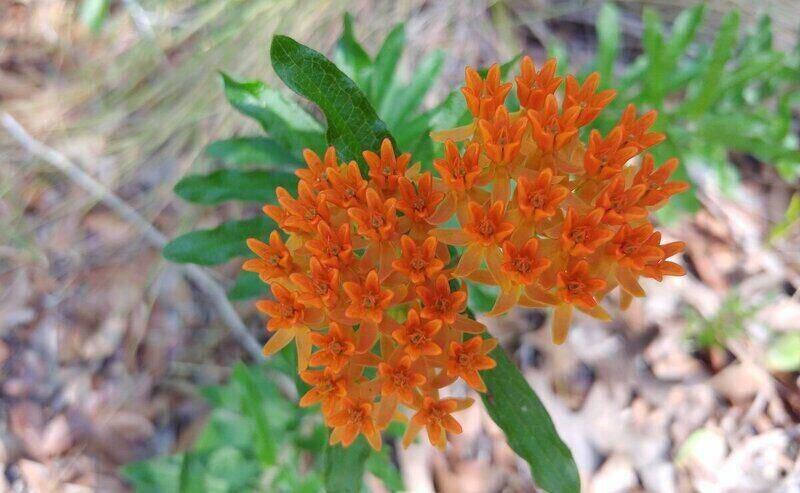
Tulsa’s location in eastern Oklahoma is not too far North and not too far South, so it’s just right for gardeners. What could be more perfect? Choosing native plants for your Tulsa garden that are adapted to the local climate means less water, less fertilizer, and fewer pests and diseases.
But which native plants are best for Tulsa’s yards? These seven native flowers, trees and shrubs are perfect for low-maintenance landscaping.
1. Bluestar (Amsonia tabernaemontana)
Bluestar, also known as blue dogbane, Is a wonderful perennial with clusters of blue flowers. It can be paired with the native coreopsis’ orange or yellow flowers to increase the colorful effect.
Bluestar’s strong 3-foot tall stems grow in clusters and can make quite a show in your flowerbed in mid-spring. The flowers attract various long-tongued pollinators, including the large carpenter bee and hummingbird moths.
Note: The common name dogbane refers to the way dogbane is distasteful to dogs, and pretty much any other grazing animal including deer, rabbits, and even slugs.
- Plant type: Bedding plant
- Hardiness zones: 3-9
- Sun: Full sun, partial shade
- Water needs: Medium to high
- Soil: Sandy, loam, clay
- Duration: Perennial
- Mature height: 2-3 feet
2. Purple coneflower (Echinacea purpurea)

Purple coneflower is a summer-flowering perennial with a basal cluster of leaves and long smooth stems from 2 to 5 feet tall. The natural purple flowers are perfect for your cut flower garden. There are many new cultivars ranging in colors from yellow to orange to white and deep pink. The showy flowers are attractive to butterflies, hummingbirds, and bees.
Purple coneflower is drought tolerant but can’t tolerate consistent strong sun exposure. They can become aggressive, so give these plants some space and you will enjoy their flowers for years to come.
- Plant type: Bedding plant
- Hardiness zones: 4-9
- Sun: Full sun, partial shade
- Water needs: Medium to low
- Soil: Sandy, loam, clay
- Duration: Perennial
- Mature height: 2-3 feet, some varieties can reach 5 feet
3. Indian blanket (Gaillardia pulchella)
Indian blanket, a sun-loving prairie wildflower that comes alive with red, orange, and yellow daisy-like flowers on 1-to-2-foot stems. Indian blanket blooms from May through August, providing continuous color in your landscape throughout the summer.
The flowers’ nectar attracts bees and butterflies, and the birds enjoy the seed heads.
Pro Tip: Deadheading will increase Indian blanket flower production and extend bloom time. These flowering plants are tolerant of dry soil. They reseed freely and can act as a ground cover in ideal situations.
- Plant type: Wildflower
- Hardiness zones: 5-10
- Sun: Full sun
- Water needs: Medium
- Soil: Sandy, loam, clay
- Duration: Perennial or hardy annual
- Mature height: 6 to 18 inches
4. Butterfly weed (Asclepia tuberosa)

Butterfly weed, blooming from late spring through late summer with bright orange flowers, is a favorite host plant for the endangered monarch butterfly. The colorful blooms also attract other pollinators, such as bees and hummingbirds.
It’s a great plant to add to your yard because it’s drought-tolerant, has very few pest problems, and can live in most soils.
Note: Don’t worry that butterfly weed loses its leaves a few times during the summer as the leaves bounce right back ready to feed the next batch of monarch caterpillars.
- Plant type: Wildflower
- Hardiness zones: 5-10b
- Sun: Full sun, part sun
- Water needs: Medium
- Soil: Sandy, loam, clay
- Duration: Perennial
- Mature height: 3-4 feet
5. Purple passion vine (Passiflora incarnata)
The purple passion vine, also known as “Maypop,” can climb with tendrils or ramble across the ground 20 to 25 feet long. The lilac and white flowers will bloom continually through the summer and are attractive to butterflies. The shiny green foliage makes a good host for butterfly caterpillars like the Gulf Fritillary.
Note: Avoid the non-native passion vine options, such as the red passion vine variety. Some of those are toxic to our native caterpillars.
- Plant type: Vine
- Hardiness zones: 5 to 9
- Sun: Full sun to part shade
- Water needs: Medium
- Soil: Sandy, loam, clay
- Duration: Perennial
- Mature height: Up to 25 feet
6. Redbud tree (Cercis canadensis)
Redbud is a small deciduous tree with many cultivars that make great additions to your native plant garden. The Texensis “Oklahoma” variant is ideal for a Tulsa garden and makes a great flowering display in early spring. This variety grows about 20 feet tall with a round crown and shiny heart-shaped leaves.
Another redbud variety of note is “Forest Pansy.” “Forest Pansy” is not as robust as “Oklahoma” and has a darker pink flower and deep burgundy, heart-shaped leaves.
Note: All redbuds are slow growers and take many years to reach their full height. The flowers appear in early spring on bare twigs and the trunk of the tree.
- Plant type: Tree
- Hardiness zones: 4-9
- Sun: Full sun to part shade
- Water needs: Medium
- Soil: Sandy, loam, clay
- Duration: Specimen
- Mature height: 20-30 feet
7. Smooth sumac (Rhus glabra)
Smooth sumac is a native large shrub or small tree — depending on its use — but it provides year-round interest. The clustered trunks give some structure to the winter garden. The shrub produces yellowish-green flowers in spring and summer, turning a deep maroon color in fall.
Smooth sumac’s fall colors of yellow, red, and orange make a spectacular early autumn statement. It produces clusters of bright red fruit that feed up to 300 different bird species.
- Plant type: Shrub
- Hardiness zones: 3-9
- Sun: Full sun to part shade
- Water needs: Low
- Soil: Sandy, loam, clay
- Duration: Deciduous
- Mature height: 8-15 feet
Still not sure what native plants to place in your Tulsa yard? Contact a Lawn Love pro in Tulsa who can help you get the right mix of low-maintenance native plants that provide seasonal interest in your landscape.
Main Photo Credit: John Flannery | Flickr | CC BY-ND 2.0
